Mammals
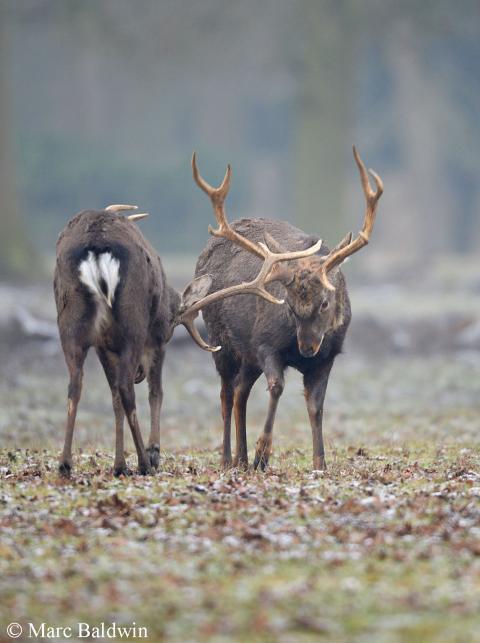
Typically the deer rut has come to an end by now, but during mild autumns it may be protracted if this month gets off to a chilly start. Either way, sika deer sometimes extend their rut into November, so some forests, particularly in Dorset, may still ring to their strained whistles. If you are going out to look for deer this (and indeed any) month, please keep your distance. Every year more photos appear in the press or on social media showing deer park visitors taking selfies right next to mature red stags resting on the grass. Fortunately, so far, the animals, being exhausted from the rut, haven’t reacted, but these are hefty creatures (a big stag can easily weigh 200kgs / 500 lbs / 30 st. or more) and things can easily end badly.
Fox society is very active this month as tensions start rising within the family group and cubs begin to disperse to look for their own territory. The fox breeding season runs from around December until February, but you might start to hear more calling even now. Badgers, by contrast, are starting to venture out less as the nights get colder. Badgers don’t hibernate, but they are generally much less active during the winter, preferring to spend the coldest months underground, where their cubs will be born early in the new year.
Many of our smaller mammals are also busy, either stocking their larders for the winter (bank voles, wood mice and squirrels, for example) or eating as much as they can to put on sufficient weight to see them through the cold months of hibernation (bats, dormice and hedgehogs fall into this category).
Hedgehogs looking for suitable hibernation spots are attracted to large piles of leaves and branches, which make ideal hibernacula. Unfortunately, such piles of garden debris often turn out to be bonfires, particularly in November. Please make an extra effort to check bonfires for hibernating hedgehogs before lighting them – ideally, build it on the day you plan to light it. Additionally, please think about leaving some of the fallen leaves in your garden or creating a leaf pile to provide your local hogs with nesting material during the autumn and early part of winter.
November is also a busy month for wildlife rescue centres as they are swamped with small hedgehogs, born late in the year and too small to survive hibernation. If you come across a small hedgehog, or any hedgehog out during the day, check out the Helping Hedgehogs article for advice and contact numbers.
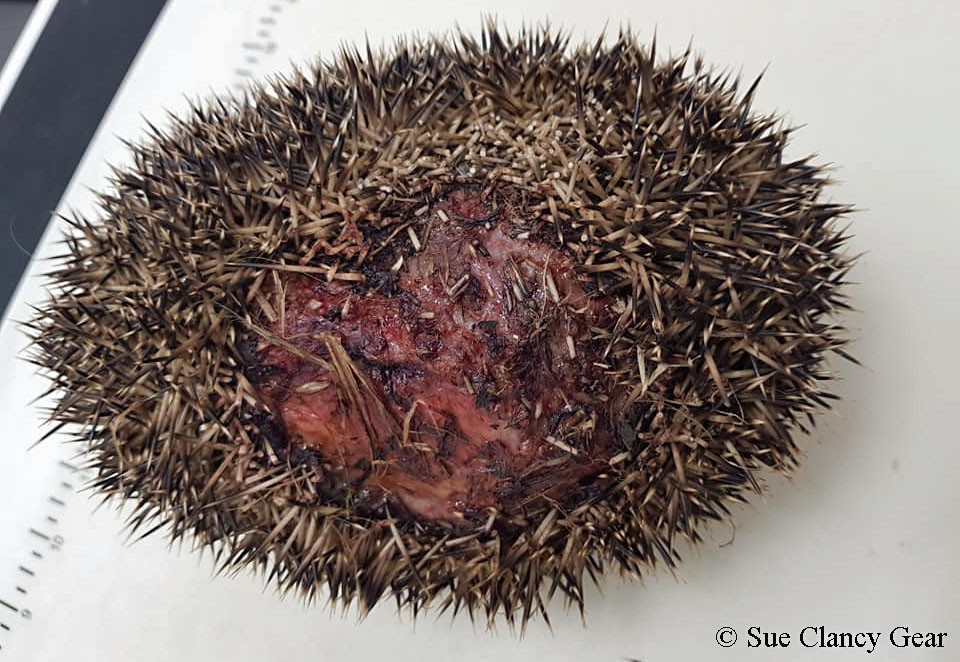
Many stay away from the coastline at this time of year owing to the wild weather that tends to blow in, but some are drawn to the power of storms as they make landfall. Not only do our coasts offer some dramatic landscapes during November, they’re also a great place for mammal-spotting. Whales and dolphins are drawn to shore following fish shoals, while seal pups are taking to the water for the first time now.
Birds
Now that the mass immigration of overwintering birds is well and truly underway, many birders are heading to estuaries to observe the flocks of sanderling, knot, dunlin, and sandpipers working the mudflats just ahead of the tide. Where birds gather in significant numbers, of course, predators can also be found, and birds of prey including peregrines and harriers are drawn by these waders. In nearby fields you can usually find swans and geese feeding; somewhere in the region of 50,000 barnacle geese fly in from as far away as Russia to spend the winter in our comparatively mild climes.
Waders and geese aren’t the only birds that form impressive flocks at this time of year. Starling populations are starting to swell too, as our 800,000 or so resident pairs are joined by millions of migrants from the continent, leading to some massive flocks wheeling and diving in the sky before going in to roost. These huge flocks are called murmurations, a term we think English monk and poet John Lydgate coined in 1470, an allusion to the murmuring noise that the birds make as they pass overhead. If you get the opportunity to experience a murmuration, I highly recommend pursuing it. The spectacle is breathtaking and some flocks contain in excess of 100,000 birds (the largest estimate I’ve seen was 750,000 birds in a single murmuration). How starlings manage to maintain such tight formation in flight, appearing to move as a single coherent entity, has long been a subject of debate and only recently have we begun to understand what’s happening.
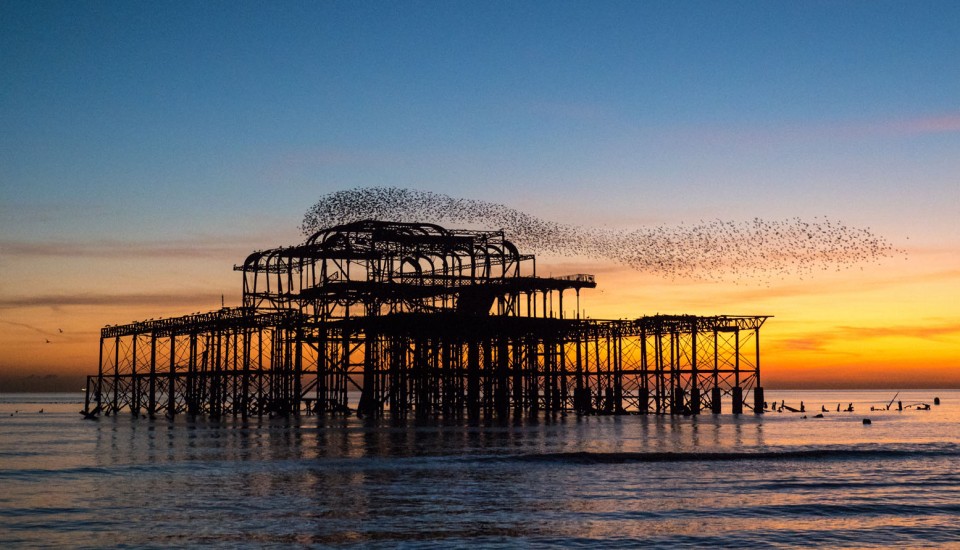
In 2014, a team led by Anne Goodenough at the University of Gloucestershire used citizen science data collected via a couple of online surveys to look at the factors that influenced starling murmurations. Their statistical analysis of more than 3,000 murmurations from 23 countries revealed that these huge flocks were primarily an anti-predator mechanism. Temperature and day length did have a small impact, but overall it was the presence of a bird of prey that was positively correlated with both the size and the duration of the murmuration. In their paper to PLOS One, Goodenough and he colleagues write:
“Our analyses also show that predator presence was related to starling behaviour at the end of murmuration: it was more likely that birds would descend en masse if a bird of prey was present. In contrast, starlings were more likely to disperse in the absence of predators.”
The following year, in a paper published by the journal Royal Society Interface, a team of Italian biologists presented data from their study of the collective changes of direction in starling flocks. Using high definition cameras, they filmed birds returning to their roosts in Rome and subjected the videos to a 3D computer algorithm. The researchers found that spontaneous turns start from individuals located at the elongated tips of the flocks, and then propagate through the group. Indeed, the birds at the periphery of the murmuration deviate from the main direction of flight much more frequently than other individuals. So essentially, being on the edge of the flock is risky and these individuals are more “jumpy”, making them more likely to change their flight direction and causing the whole flock to follow. When you have many nervous birds around the edge of such a giant flock all doing the same, the result is this seemingly choreographed “sky dance”. Indeed, data from Goodenough and others have found that predators can influence the shapes and waves within a murmuration. If you find it hard to reconcile such a mundane explanation for such an apparently artistic and mysterious protean body, remember our brains are very good at picking out patterns, whether there’s one to find or not – shapes in clouds, faces in burnt toast, ghosts of loved ones in shadowy hallways and so forth.
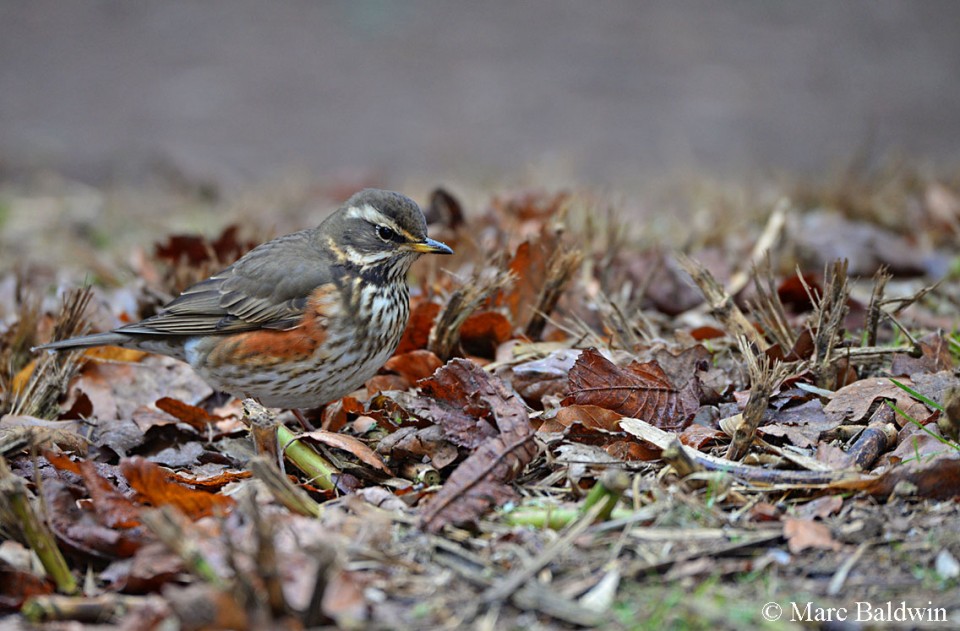
Brighton Pier, Aberystwyth Pier, the Somerset Levels, Huddersfield station and the Forth Bridge in Edinburgh are particularly good places to see these spectacular starling flocks. On average, the murmurations last about 30 minutes, after which the birds drop down to roost.
Other species are starting to flock together now, too, albeit in less impressive style. Increasing aggregations of thrushes and finches can be seen in our countryside and woodland in November. As autumn moves into winter, the thrushes will be joined by more fieldfares and redwings from Scandinavia and Finland. Indeed, it is estimated that as many as one million Fennoscandian immigrant fieldfares cross the North Sea to overwinter in Britain, timing their arrival for the peak of the berry season. In Anglo-Saxon, "felde fare" meant one who travels over fields, which is an apt description of this winter thrush. Mixed finch flocks on farmland during this month will contain goldfinches, chaffinches and bramblings. Rooks and jackdaws are also forming large groups now, and rooks will start pairing up as we approach Christmas.
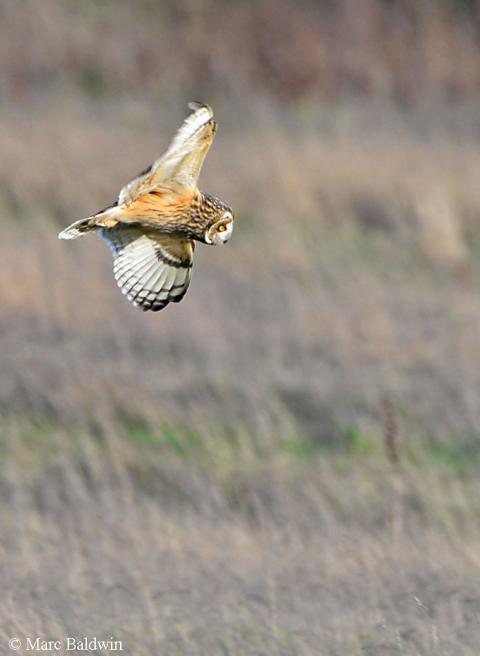
Some birds will also move south within the UK, and it is during November that hen harriers usually appear back here on the New Forest, many having travelled down from their breeding grounds in the uplands of northern England, north Wales and Scotland. During autumn, our resident birds are joined by individuals from the continent who overwinter in Britain and Ireland. Short-eared owls also move further south during winter and are frequently seen around our coasts as autumn moves to winter. Indeed, now is quite a good time for owl-spotting; as leaves are stripped from the trees by the autumn storms, these birds can be easier to see. In particular, tawny owls are easier to track down at this time of year because they are also re-establishing territories and pair-bonds, which entails quite a bit of calling. Going out at dusk to your local park or woodland will often allow you to locate the tawny’s daytime roost, from which it frequently calls before moving off to hunt. If you can relocate that site during the day, you stand a reasonable chance of viewing the owl itself.
Another predatory bird that migrates to spend the winter here in the New Forest is the great grey shrike, which usually arrives in the south-east of the country during November from its breeding grounds in Scandinavia. Shrikes are small predatory birds that can often be seen on heath and gorse stands, perched high up, waiting for a passing meal – small birds, rodents and shrews and beetles are all on the menu. Also known as “butcher birds”, shrikes frequently impale their prey on barbed wire fences, thorns and branches.
Many of our summer visitors will have left now, but you may be lucky and get a view of a straggling osprey passing through southern England on its way to its wintering ground in South Africa.
Reptiles and amphibians
Reptiles will still be out and about until the air temperature drops below about 10 Celsius (50 F) and even below that they can sometimes be found basking in sheltered, sunny spots. Nonetheless, generally there is little herpetological (snake, lizard, frog, toad and newt) activity this month. Some frogs and toads will remain in ponds all winter, hibernating at the bottom among the sediment, but most amphibians will spend the winter under logs and leaf litter until things warm up next spring. If you can leave an area of your garden untidy this winter it will likely provide a torpor site for some of your local amphibians and invertebrates.
Fish
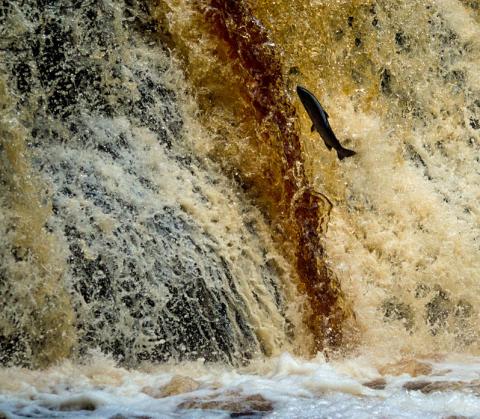
Not all cold-blooded animals are hunkering down for the winter and November represents the peak of the salmon run, during which mature fish work their way up our rivers from the Atlantic to their spawning grounds. These fish hatched out high in these freshwater rivers in which they spent up to eight years feeding and growing before migrating to the sea where they’ve spent the past four or five years. Having reached breeding age, they have been congregating in estuaries for the last few weeks waiting for the autumn rains to swell the rivers and provide sufficiently high water levels for them to make their way back. During this journey the fish do not feed; they remain completely focused on their goal, hurling themselves against torrents of water, up waterfalls and over weirs and dykes.
Those that make it to their shallow spawning grounds pair up and, after a short jostling courtship, the female releases her eggs for the male to fertilise by releasing a cloud of sperm into the water. Both die shortly thereafter and their bodies return to the river in which they were conceived. There are several locations where you can watch the salmon run – check out this BBC blog for some recommendations.
Another fish, the Arctic char, is also breeding this month, with the males particularly resplendent in their red breeding ‘flush’. Char are much more cold-tolerant than our other native trout and salmon, allowing them to thrive in deep, cold post-glacial lakes as well as more fertile, shallower waters of Scottish and Irish lochs.
Invertebrates
There are a few butterflies still on the wing, visiting ivy and windfall fruits, including red admirals, peacocks and commas. The aptly-named November moths (Epirrita sp.) are still active in this month – there are several species of these slate grey-to-brown moths, which can cause confusion when it comes to identifying them, but if you’re moth trapping in this month the UK Moths website might be of assistance.
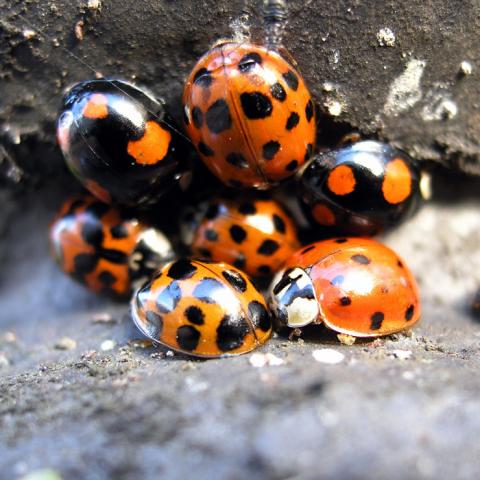
Ladybirds will start gathering en masse under bark, in window frames and sheds/garages to spend the winter in torpor, while most beetles will be retreating underground or under logs. Many insects (even some amphibians) will overwinter in long grass and leaving an area of your lawn overgrown can be immensely valuable to their hibernation. If you can create a log pile, even better.
If you’re working in the garden this month you may dig up some small brown plastic-looking cases. These are the pupae of moths and beetles and if you re-bury them where you find them, they should pupate next year. You may also come across bramble leaves that look like someone’s scribbled on them with white chalk or Tippex – this is the handiwork of the caterpillars of the bramble leaf-miner (Stigmella aurella) as they munch their way between the top and bottom layers of the leaf. If you look carefully you'll notice the tunnel widen as the larvae grows and holding the leaf against a light should reveal a dark trail of frasse (insect droppings). Country-wide, hundreds of moths, fly, sawfly and beetle species have larvae that mine leaves and this modus operandi serves a dual function: it helps hide the larva from predators and also allows it access to the sap and less well defended cells of the leaf, rather than the outside layers that contain chemicals aimed at deterring leaf predators. You can learn more and record your sightings on the British Leafminers website.
There will be a few spiders around, particularly if October was mild, but these will gradually start retiring if the weather cools, although some in houses and sheds/garages may continue to make their presence known into next month. In our parks and woodlands most spiders either die at the end of the breeding season, before the cold sets in, or overwinter in the leaf litter. Slugs and snails, particularly the giant leopard slug, may also be found out and about during November, particularly if the weather remains mild and damp.
Plants and fungi
Late autumn/early winter is a good time to look for mosses, lichens, wall ferns and spleenworts. November sees flowering ivy offering late-flying insects a much-needed source of nectar, while wild fruit comes in the form of black bryony berries, a few rowan trees with fruit, Cotoneaster berries and, of course, holly berries.
Fungi are also evident this month, with the bright but deadly red-capped fly agaric, the other-worldly looking devil’s fingers, the delicate purple amethyst deceiver and the innocuous brown deadman’s fingers around in November. It’s worth bearing in mind that the fungi we see are just the tip of the iceberg, so to speak. The mushroom is the fruiting body, the purpose of which is to produce and distribute spores, and only a small part of the fungus. The bulk of the fungus is present year-round in the wood/soil/humus and consists of a large web of microscopic cotton-like threads called hyphae that may cover several miles; the whole web of hyphae making up a single fungus is called a mycelium.
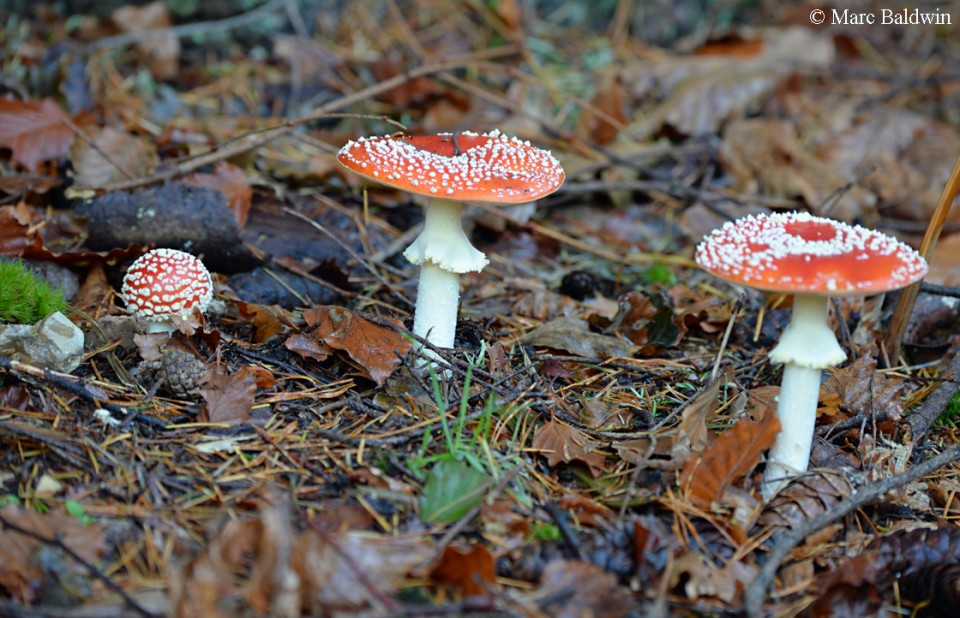
The mycelium branches out into the substratum and the long, thin hyphae allow it to absorb nutrients and water across a huge surface area. Indeed, fungi have no chlorophyll, which means they cannot photosynthesise to produce carbohydrates (food) as plants do. Instead, most fungi are saphrotrophs; they attack and digest plants and animals (living or dead). A few species enter into a symbiotic relationship (known as a mycorrhizal association) with certain plants, their hyphae invading the root systems of their host to steal sugars from their circulation; in return, the fungi act as an extension of the plant’s root network, allowing it to take up nutrients from a much wider area than it could manage on its own.
During the autumn, the mild and wet conditions prompt the modification of either individual hyphae or sections of the mycelium (depending on species) into the fruiting bodies that we know as mushrooms or toadstools. The fruiting body expands quickly (it doesn’t technically grow), often in a matter of hours. The hypha becomes modified into a button-like structure called a hymenophore and, when conditions are right, the fruiting body absorbs moisture and air from the environment causing the cells in the tissue to expand and the fruiting body to inflate. The hymenophore of many species is covered with a thin membrane called a hymenium (or universal veil), which is torn as the fruiting body expands; the remnants often remain as a ‘skirt’ around the fungi’s stem and, as in the case of the fly agaric, pieces may stick to the cap (these are the white spots). The spores are released from gills or veins (again, depending on species) on the underside of the fruiting body’s cap; these structures need to be aligned correctly so they run parallel to the ground (allowing the spores to drop under the influence of gravity) and the fruiting body can realign the cap by bending the stem as it inflates, allowing it to expand out of a vertical surface.